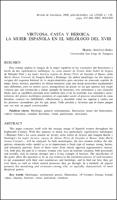Por favor, use este identificador para citar o enlazar este ítem:
https://repositorio.usj.es/handle/123456789/416
Registro completo de metadatos
| Campo DC | Valor | Lengua/Idioma |
|---|---|---|
| dc.contributor.author | Angulo Egea, María | - |
| dc.date.accessioned | 2020-10-30T10:35:02Z | - |
| dc.date.available | 2020-10-30T10:35:02Z | - |
| dc.date.issued | 2006 | - |
| dc.identifier.citation | Angulo Egea, M. (2006). Virtuosa, casta y heroica. La mujer española en el Melólogo del XVIII. Revista de literatura, 68(136), 471-488. doi:http://dx.doi.org/10.3989/revliteratura.2006.v68.i136.16 | es_ES |
| dc.identifier.issn | 0034-849X | es_ES |
| dc.identifier.uri | https://repositorio.usj.es/handle/123456789/416 | - |
| dc.description | This paper concerns itself with the onstage image of Spanish women throughout theEighteenth Century. With this purpose in mind, two particularly significative melologues—Mariano Nifo’s La casta amante de Teruel, doña Isabel de Segura and Joaquín Barón yDomingo’s La mujer heroica, esposa de Alonso Pérez de Guzmán el Bueno, doña MaríaAlonso Coronel— will be analysed. In both monologues, the two women eschew the ubi-quitous «domestic-wife» model so as to impersonate a fresh type of woman: strong, heroic,and ultimately patriotic. Each of them stems from utterly opposed argumentative stances.Yet, both play the part of a virtuous woman who faces an extreme situation, both personallyand socially, only to emerge stronger and a living example of heroism. The specificities ofthe genre allow the spectator to be an eye-witness to the emotional process of such heroines;to get acquainted with their own weaknesses and hardships; and to find out how they getover them, as well as which mental processes they go through. In a nutshell: all aspectspromote the moralising and awareness-raising role, so typically characteristic of mosttheatrical genres | es_ES |
| dc.description.abstract | Este trabajo analiza la imagen de la mujer española en los escenarios del Setecientos através de dos significativos melólogos: La casta amante de Teruel, doña Isabel de Segurade Mariano Nifo y La mujer heroica, esposa de Alonso Pérez de Guzmán el Bueno, doñaMaría Alonso Coronel, de Joaquín Barón y Domingo. En ambos monólogos las dos mujeresescapan del esquema habitual de la mujer-doméstica para encarnar un renovado espíritu demujer fuerte, heroica, patriótica en última instancia; cada una desde posiciones argumentalesmuy diferentes, pero en ambos casos, protagonistas de piezas en las que aparece una mujervirtuosa que sale fortalecida y dando ejemplo de heroísmo, tras enfrentarse a una situaciónlímite para su equilibrio personal pero también para el de la sociedad. Las singulares carac-terísticas del género melológico permiten al espectador asistir al proceso emocional de estasheroínas, conocer sus debilidades, tribulaciones y descubrir cómo las superan y cuáles sonlos procesos razonadores por los que pasan. Todo permite y favorece que el teatro juegueuna vez más un papel concienciador. | es_ES |
| dc.format.mimetype | application/pdf | es_ES |
| dc.language.iso | spa | es_ES |
| dc.publisher | CSIC Consejo Superior de Investigaciones Cientificas | es_ES |
| dc.rights | Atribución 4.0 Internacional | * |
| dc.rights.uri | http://creativecommons.org/licenses/by/4.0/ | * |
| dc.subject | Melólogo | es_ES |
| dc.subject | Géneros sentimentales | es_ES |
| dc.subject | Ilustración | es_ES |
| dc.subject | Teatro del Setecientos | es_ES |
| dc.subject | Valores femeninos | es_ES |
| dc.subject | Castidad | es_ES |
| dc.subject | Heroísmo | es_ES |
| dc.subject | Virtud | es_ES |
| dc.subject | Patriotismo | es_ES |
| dc.subject | Emociones | es_ES |
| dc.title | Virtuosa, casta y heroica. La mujer Española en el melólogo del XVIII | es_ES |
| dc.title.alternative | Virtuous, chaste and heroic. The Spanish woman in the eighteenth melólogo | es_ES |
| dc.type | info:eu-repo/semantics/article | es_ES |
| dc.subject.unesco | Teatro | es_ES |
| dc.identifier.publicationfirstpage | 471 | es_ES |
| dc.identifier.publicationlastpage | 488 | es_ES |
| dc.identifier.doi | https://doi.org/10.3989/revliteratura.2006.v68.i136.16 | es_ES |
| dc.rights.accessrights | info:eu-repo/semantics/openAccess | es_ES |
| Aparece en las colecciones: | Artículos de revistas | |
Ficheros en este ítem:
| Fichero | Descripción | Tamaño | Formato | |
|---|---|---|---|---|
| Virtuosa, casta y heroica. La mujer Española en el melólogo del XVIII.pdf | 133,89 kB | Adobe PDF |  Visualizar/Abrir |
Este ítem está sujeto a una licencia Creative Commons Licencia Creative Commons

